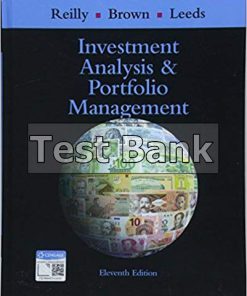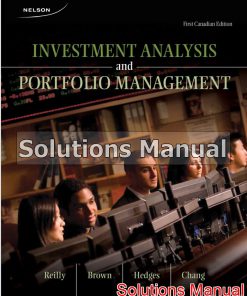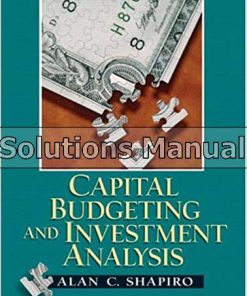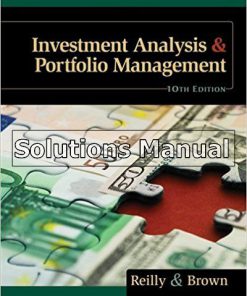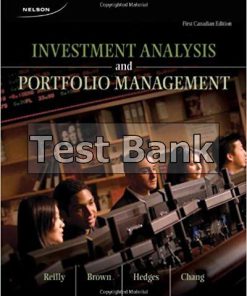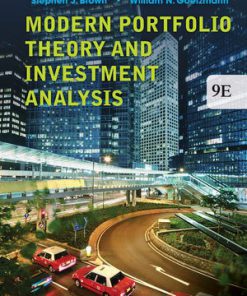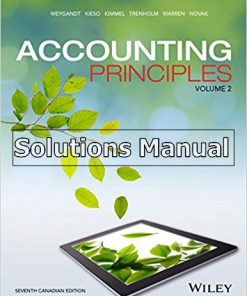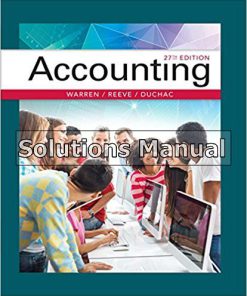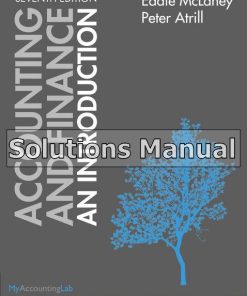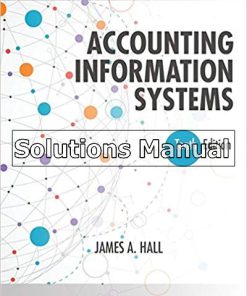Modern Portfolio Theory and Investment Analysis 9th Edition Elton Solutions Manual
$50.00 Original price was: $50.00.$26.99Current price is: $26.99.
Modern Portfolio Theory and Investment Analysis 9th Edition Elton Solutions Manual.
This is completed downloadable of Modern Portfolio Theory and Investment Analysis 9th Edition Elton Solutions Manual

Product Details:
- ISBN-10 : 1118469941
- ISBN-13 : 978-1118469941
- Author: Edwin J. Elton (Author), Martin J. Gruber (Author), Stephen J. Brown (Author), William N. Goetzmann (Author)
Modern Portfolio Theory and Investment Analysis, 9th Editionexamines the characteristics and analysis of individual securities, as well as the theory and practice of optimally combining securities into portfolios. It stresses the economic intuition behind the subject matter while presenting advanced concepts of investment analysis and portfolio management.
The authors present material that captures the state of modern portfolio analysis, general equilibrium theory, and investment analysis in an accessible and intuitive manner.
Table of Content:
Part 1 Introduction 1
Chapter 1 Introduction 2
Outline of the Book 2
The Economic Theory of Choice: An Illustration under Certainty 4
Conclusion 8
Multiple Assets and Risk 8
Questions and Problems 9
Bibliography 10
Chapter 2 Financial Securities 11
Types of Marketable Financial Securities 11
The Return Characteristics of Alternative Security Types 19
Stock Market Indexes 21
Bond Market Indexes 22
Conclusion 23
Chapter 3 Financial Markets 24
Trading Mechanics 24
Margin 27
Markets 30
Trade Types and Costs 36
Conclusion 38
Part 2 PORTFOLIO ANALYSIS 39
Section 1 Mean Variance Portfolio Theory 41
Chapter 4 The Characteristics of The Opportunity Set Under Risk 42
Determining the Average Outcome 43
A Measure of Dispersion 44
Variance of Combinations of Assets 47
Characteristics of Portfolios in General 50
Two Concluding Examples 59
Conclusion 62
Questions and Problems 62
Bibliography 64
Chapter 5 Delineating Efficient Portfolios 65
Combinations of Two Risky Assets Revisited: Short Sales Not Allowed 65
The Shape of the Portfolio Possibilities Curve 74
The Efficient Frontier with Riskless Lending and Borrowing 81
Examples and Applications 85
Three Examples 89
Conclusion 92
Questions and Problems 92
Bibliography 93
Chapter 6 Techniques for Calculating The Efficient Frontier 95
Short Sales Allowed with Riskless Lending and Borrowing 96
Short Sales Allowed: No Riskless Lending and Borrowing 100
Riskless Lending and Borrowing with Short Sales Not Allowed 100
No Short Selling and No Riskless Lending and Borrowing 101
The Incorporation of Additional Constraints 102
An Example 103
Conclusion 106
Appendix A: An Alternative Definition of Short Sales 106
Appendix B: Determining the Derivative 107
Appendix C: Solving Systems of Simultaneous Equations 111
Appendix D: A General Solution 114
Appendix E: Quadratic Programming and Kuhn–Tucker Conditions 118
Questions and Problems 121
Bibliography 122
Section 2 Simplifying The Portfolio Selection Process 125
Chapter 7 The Correlation Structure Of Security Returns—The Single-Index Model 126
The Inputs to Portfolio Analysis 127
Single-Index Models: An Overview 128
Characteristics of the Single-Index Model 133
Estimating Beta 135
The Market Model 148
An Example 149
Questions and Problems 150
Bibliography 152
Chapter 8 The Correlation Structure Of Security Returns—Multi-Index Models And Grouping Techniques 155
Multi-index Models 156
Average Correlation Models 162
Mixed Models 163
Fundamental Multi-index Models 163
Conclusion 169
Appendix A: Procedure for Reducing Any Multi-index Model to a
Multi-index Model with Orthogonal Indexes 169
Appendix B: Mean Return, Variance, and Covariance of a Multi-index Model 170
Questions and Problems 172
Bibliography 173
Chapter 9 Simple Techniques for Determining The Efficient Frontier 176
The Single-index Model 177
Security Selection with a Purchasable Index 188
The Constant Correlation Model 189
Other Return Structures 192
An Example 192
Conclusion 193
Appendix A: Single-index Model—Short Sales Allowed 194
Appendix B: Constant Correlation Coefficient—Short Sales Allowed 196
Appendix C: Single-index Model—Short Sales Not Allowed 197
Appendix D: Constant Correlation Coefficient—Short Sales Not Allowed 199
Appendix E: Single-index Model, Short Sales Allowed, and a Market Asset 201
Questions and Problems 201
Bibliography 202
Section 3 Selecting The Optimum Portfolio 205
Chapter 10 Estimating Expected Returns 206
Aggregate Asset Allocation 206
Forecasting Individual Security Returns 212
Portfolio Analysis with Discrete Data 214
Appendix: The Ross Recovery Theorem—A New Approach to
Using Market Data to Calculate Expected Return 215
Bibliography 218
Chapter 11 How to Select Among The Portfolios In The Opportunity Set 220
Choosing Directly 220
An Introduction to Preference Functions 221
Risk Tolerance Functions 224
Safety First 226
Maximizing the Geometric Mean Return 232
Value at Risk (VaR) 234
Utility and the Equity Risk Premium 235
Optimal Investment Strategies with Investor Liabilities 237
Liabilities and Safety-First Portfolio Selection 241
Simulations in Portfolio Choice 241
Conclusion 247
Appendix: The Economic Properties of Utility Functions 247
Relative Risk Aversion and Wealth 249
Questions and Problems 249
Bibliography 250
Section 4 Widening the Selection Universe 255
Chapter 12 International Diversification 256
Historical Background 257
Calculating the Return on Foreign Investments 257
The Risk of Foreign Securities 261
Market Integration 267
Returns from International Diversification 268
The Effect of Exchange Risk 269
Return Expectations and Portfolio Performance 270
Emerging Markets 272
Other Evidence on Internationally Diversified Portfolios 276
Sovereign Funds 278
Models for Managing International Portfolios 280
Conclusion 283
Questions and Problems 284
Bibliography 285
Part 3 Models of Equilibrium in The Capital Markets 289
Chapter 13 The Standard Capital Asset Pricing Model 290
The Assumptions Underlying the Standard Capital Asset Pricing Model (CAPM) 290
The CAPM 291
Prices and the CAPM 300
Conclusion 302
Appendix: Appropriateness of the Single-Period Asset Pricing Model 304
Questions and Problems 308
Bibliography 309
Chapter 14 Nonstandard Forms of Capital Asset Pricing Models 311
Short Sales Disallowed 312
Modifications of Riskless Lending and Borrowing 312
Personal Taxes 322
Nonmarketable Assets 324
Heterogeneous Expectations 326
Non-Price-Taking Behavior 327
Multiperiod CAPM 327
The Multi-beta CAPM 328
Consumption CAPM 328
Conclusion 330
Appendix: Derivation of the General Equilibrium with Taxes 331
Questions and Problems 333
Bibliography 334
Chapter 15 EMPIRICAL TESTS OF EQUILIBRIUM MODELS 340
The Models—Ex Ante Expectations and Ex Post Tests 340
Empirical Tests of the CAPM 341
Testing Some Alternative Forms of the CAPM Model 352
Testing the Posttax Form of the CAPM Model 353
Some Reservations about Traditional Tests of General Equilibrium Relationships and Some New Research 356
Conclusion 358
Questions and Problems 359
Bibliography 360
Chapter 16 The Arbitrage Pricing Model Apt—A Multifactor Approach To Explaining Asset Prices 364
APT—What Is It? 364
Estimating and Testing APT 369
APT and CAPM 381
Recapitulation 382
Term Structure Factor 392
Credit Risk Factor 392
Foreign Exchange [FX] Carry 393
Value Factor 393
Size Factor 393
Momentum Factor 393
Volatility Factor 394
Liquidity Factor 394
Inflation Factor 395
GDP Factor 395
Equity Risk Premium 396
Limitations of Factor Investing 396
Factor Investing Summary 397
Conclusion 397
Appendix A: A Simple Example of Factor Analysis 397
Appendix B: Specification of the APT with an Unobserved Market Factor 399
Questions and Problems 400
Bibliography 401
Part 4 Security Analysis and Portfolio Theory 409
Chapter 17 Efficient Markets 410
Early Development 411
The Next Stages of Theory 412
Recent Theory 414
Some Background 415
Testing the EMH 416
Tests of Return Predictability 417
Tests on Prices and Returns 417
Monthly Patterns 419
Announcement and Price Return 431
Methodology of Event Studies 432
Strong-Form Efficiency 437
Market Rationality 440
Conclusion 442
Questions and Problems 442
Bibliography 443
Chapter 18 The Valuation Process 454
Discounted Cash Flow Models 455
Cross-Sectional Regression Analysis 467
An Ongoing System 471
Conclusion 476
Questions and Problems 476
Bibliography 477
Chapter 19 Earnings Estimation 481
The Elusive Number Called Earnings 481
The Importance of Earnings 484
Characteristics of Earnings and Earnings Forecasts 487
Conclusion 495
Questions and Problems 496
Bibliography 496
Chapter 20 Behavioral Finance, Investor Decision Making, and Asset Prices 499
Prospect Theory and Decision Making under Uncertainty 499
Biases from Laboratory Experiments 502
Summary of Investor Behavior 505
Behavioral Finance and Asset Pricing Theory 506
Bibliography 513
Chapter 21 Interest Rate Theory And The Pricing Of Bonds 517
An Introduction to Debt Securities 518
The Many Definitions of Rates 519
Bond Prices and Spot Rates 526
Determining Spot Rates 528
The Determinants of Bond Prices 530
Collateral Mortgage Obligations 546
The Financial Crisis of 2008 547
Conclusion 549
Appendix A: Special Considerations in Bond Pricing 549
Appendix B: Estimating Spot Rates 550
Appendix C: Calculating Bond Equivalent Yield and Effective Annual Yield 552
Questions and Problems 552
Bibliography 553
Chapter 22 The Management of Bond Portfolios 557
Duration 557
Protecting against Term Structure Shifts 565
Bond Portfolio Management of Yearly Returns 569
Swaps 578
Appendix A: Duration Measures 580
Appendix B: Exact Matching Programs 584
Appendix C: Bond-Swapping Techniques 586
Appendix D: Convexity 587
Questions and Problems 588
Bibliography 589
Chapter 23 Option Pricing Theory 592
Types of Options 592
Some Basic Characteristics of Option Values 598
Valuation Models 603
Artificial or Homemade Options 614
Uses of Options 615
Conclusion 618
Appendix A: Derivation of the Binomial Formula 618
Appendix B: Derivation of the Black–Scholes Formula 621
Questions and Problems 623
Bibliography 624
Chapter 24 The Valuation and Uses of Financial Futures 630
Description of Financial Futures 630
Valuation of Financial Futures 634
The Uses of Financial Futures 639
Nonfinancial Futures and
Commodity Funds 643
Questions and Problems 644
Bibliography 645
Part 5 Evaluating the Investment Process 647
Chapter 25 Mutual Funds 648
Open-End Mutual Funds 649
Closed-End Mutual Funds 652
Exchange-Traded Funds (ETFs) 655
Conclusion 658
Bibliography 658
Chapter 26 Evaluation of Portfolio Performance 660
Evaluation Techniques 661
A Manipulation-Proof Performance Measure 669
Timing 670
Holding Measures of Timing 674
Multi-index Models and Performance Measurement 675
Using Holdings Data to Measure Performance Directly 678
Time-Varying Betas 679
Conditional Models of Performance Measurement, Bayesian Analysis, and Stochastic Discount Factors 679
Bayesian Analysis 680
Stochastic Discount Factors 681
What’s a Researcher to Do? 681
Measuring the Performance of Active Bond Funds 682
The Performance of Actively Managed Mutual Funds 682
How Have Mutual Funds Done? 682
The Persistence of Performance 684
Persistence 684
Appendix: The Use of APT Models to Evaluate and Diagnose Performance 689
Questions and Problems 693
Bibliography 693
Chapter 27 Evaluation Of Security Analysis 699
Why the Emphasis on Earnings? 700
The Evaluation of Earnings Forecasts 701
Evaluating the Valuation Process 708
Conclusion 711
Questions and Problems 712
Bibliography 712
Chapter 28 Portfolio Management Revisited 714
Managing Stock Portfolios 715
Active Management 718
Passive Versus Active 719
International Diversification 720
Bond Management 720
Bond and Stock Investment with a Liability Stream 723
Bibliography 728
Index 731
People Also Search:
modern portfolio theory and investment analysis elton
modern portfolio theory and investment analysis 9th edition elton
modern portfolio theory and investment analysis 9th edition
modern portfolio theory and investment analysis 9th edition download scribd
modern portfolio theory and investment analysis 9th edition solution manual download pdf
Instant download after Payment is complete
You may also like…
Management
Investment Analysis and Portfolio Management Canadian 1st Edition Reilly Solutions Manual
Related products
Solutions Manual
Solutions Manual
Solutions Manual
A+ Guide to IT Technical Support Hardware and Software 9th Edition Andrews Solutions Manual
Solutions Manual
Accounting Texts and Cases 13th Edition Anthony Solutions Manual
Solutions Manual
Accounting Information Systems 10th Edition Hall Solutions Manual




